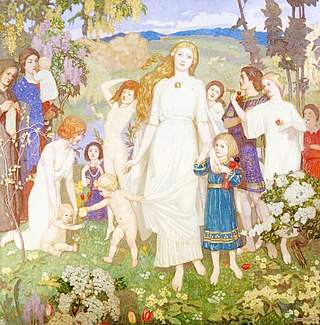
The Brittoniclanguages form one of the two branches of the Insular Celtic language family; the other is Goidelic. It comprises the extant languages Breton, Cornish, and Welsh. The name Brythonic was derived by Welsh Celticist John Rhys from the Welsh word Brython, meaning Ancient Britons as opposed to an Anglo-Saxon or Gael.

The Morrígan or Mórrígan, also known as Morrígu, is a figure from Irish mythology. The name is Mór-ríoghan in modern Irish before the spelling reform, and it has been translated as "great queen" or "phantom queen".

The Savinja is a river in northeast Slovenia which flows mostly in the Upper and Lower Savinja Valley and through the cities of Celje and Laško. The Savinja is the main river of the Savinja Alps. It flows into the Sava River at the town of Zidani Most. It has often flooded, such as in the 1960s, 1990, and 1995. The Savinja has a length of 101.75 kilometres (63.22 mi) and a catchment area of 1,847.7 km2 (713.4 sq mi).
*Agronā was a hypothetical reconstructed Proto-Celtic name for the River Ayr in Scotland, later applied to the River Aeron in Wales. The claim is linguistic and first appeared in William J. Watson's Celtic Placenames of Scotland (1926). Watson suggested the River Ayr in Scotland could be worked back to a hypothetical Proto-Celtic "river goddess of slaughter and carnage" and that the deity name was *Agronā. At that time there were many questionable Scottish nationalist attempts to use the River Ayr place-name to claim Taliesin's battle poems for Scotland and Watson's derivation strongly and implicitly supported such claims. This hypothesis has also been used to support locating the ancient kingdom of Aeron in modern-day Ayrshire.
In Welsh mythology, Amaethon was the god of agriculture, and the son of the goddess Dôn. His name means "labourer" or "ploughman", and he is cited as being responsible for the Cad Goddeu, or "Battle of Trees", between the lord of the otherworld, Arawn, and the Children of Dôn.
*Danu ([ˈdanu]) is a hypothesised entity in Irish mythology whose sole attestation is in the genitive in the name of the Tuatha dé Danann, which may mean "the peoples of the goddess Danu" in Old Irish. Despite her complete absence from the primary texts, some later Victorian folklorists attempted to ascribe certain attributes to Danu, such as association with motherhood or agricultural prosperity.

Anu or Ana is the name of a goddess mentioned briefly in Irish mythology.

Brigid or Brigit, also Bríg, is a goddess of pre-Christian Ireland. She appears in Irish mythology as a member of the Tuatha Dé Danann, the daughter of the Dagda and wife of Bres, with whom she had a son named Ruadán.
Borvo or Bormo was an ancient Celtic god of healing springs worshipped in Gaul and Gallaecia. He was sometimes identified with the Graeco-Roman god Apollo, although his cult had preserved a high degree of autonomy during the Roman period.

Durga is a major Hindu goddess, worshipped as a principal aspect of the mother goddess Mahadevi. She is associated with protection, strength, motherhood, destruction, and wars.
In Hindu mythology the Angiris are a group of celestial beings who are descendants of the Fire God Agni and the Goddess Agneya, responsible for watching over humans performing Yagna (sacrifices) and protecting the sacrificial fires

Proto-Indo-European mythology is the body of myths and deities associated with the Proto-Indo-Europeans, speakers of the hypothesized Proto-Indo-European language. Although the mythological motifs are not directly attested – since Proto-Indo-European speakers lived in preliterate societies – scholars of comparative mythology have reconstructed details from inherited similarities found among Indo-European languages, based on the assumption that parts of the Proto-Indo-Europeans' original belief systems survived in the daughter traditions.

In the localised Celtic polytheism practised in Great Britain, Sulis was a deity worshiped at the thermal spring of Bath. She was worshiped by the Romano-British as Sulis Minerva, whose votive objects and inscribed lead tablets suggest that she was conceived of both as a nourishing, life-giving mother goddess and as an effective agent of curses invoked by her votaries.

Proto-Indo-European (PIE) is the reconstructed common ancestor of the Indo-European language family. No direct record of Proto-Indo-European exists; its proposed features have been derived by linguistic reconstruction from documented Indo-European languages.
Cathubodua is the name of a Gaulish battle goddess.

Armenian mythology originated in ancient Indo-European traditions, specifically Proto-Armenian, and gradually incorporated Hurro-Urartian, Mesopotamian, Iranian, and Greek beliefs and deities.

Brigantia or Brigindo was a goddess in Celtic religion of Late Antiquity.
In historical linguistics, the Germanic parent language (GPL), also known as Pre-Germanic Indo-European (PreGmc) or Pre-Proto-Germanic (PPG), is the reconstructed language of the Germanic branch of the Indo-European language family that was spoken c. 2500 BC – c. 500 BC, after the branch had diverged from Proto-Indo-European but before it evolved into Proto-Germanic.
Argia, Argea, or Argeia may refer to several figures in Greek mythology:










